When to dig dahlias in the fall and how to store them in the winter?

Dahlias are one of the brightest and most memorable flowers growing in their summer cottage. Plants are quite unpretentious during the growing season, but in winter they require special treatment. It's all about their delicate tubers, which do not tolerate cold weather and need a warm and moderately humid room. In this regard, it is important not to miss the beginning of the night autumn frosts and to provide the tubers with comfortable storage conditions.
Timing
Dahlias are natives of South America, and therefore poorly adapted to the harsh climatic conditions of our country. The gardener's task is to accurately determine the time of preparation of the plant for wintering and the timing of digging out the tubers. In regions with a sharply continental climate, when night temperatures are already approaching zero, and it is still quite hot during the day, dahlias are spud like a potato, protecting the bulbs from freezing.
You can start digging out dahlias only when the leaves begin to turn black from frost.
This happens at different times in each region, therefore, one should be guided in this matter not by a specific date, but by the state of the plant... So, in the regions of central Russia and in the Moscow region, the tubers are dug up in the second half of October. By this time, they had already endured light frosts, hardened a little and could easily endure home wintering. In the eastern part of our country, as well as in Siberia and beyond the Urals, the time of excavation is usually shifted by 2-3 weeks and depends entirely on the weather set in the fall.
The main thing is not to miss the beginning of regression, when the first frostbitten leaves are found, immediately remove the tubers from the ground. Otherwise, rot will appear on the damaged parts of the plant, which will quickly move to the root system and destroy the plant. However, it is also not necessary to dig up the bulbs too early. In the first days of autumn, most of the leaves still retain their elasticity and green color, which means the continuation of the process of natural root nutrition and preparation of the buds for the next flowering.
Of course, you should not deprive the plant of the latest solar procedures, on the contrary, it is necessary to give it the opportunity to store as many nutrients as possible.

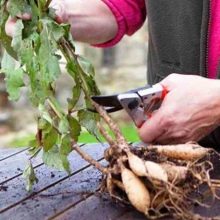
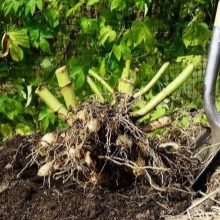
Preparation
They begin to prepare dahlias for digging in advance. To do this, gradually reduce watering.so that excess moisture does not provoke the onset of fungal infections, and a week before digging out, they completely stop. Besides, perform sanitary pruning of the bushremoving shoots without buds, lower leaves and dried flowers. In this state, the plant stays in the open ground until the time comes to dig it up.
The procedure for digging out the bulbs from the ground is not difficult and consists of several successive stages. First with a secateurs remove all stems and leave shoots 10-15 cm high. Cutting the stems even shorter is not recommended, as this can provoke infection or water leakage into the tuber. Then the bush unbuckle and gently dig in with a pitchfork at a distance of 20 cm from the stem... Tubers are also removed with a pitchfork, being careful not to damage their surface and not pulling out the trimming of the stems.

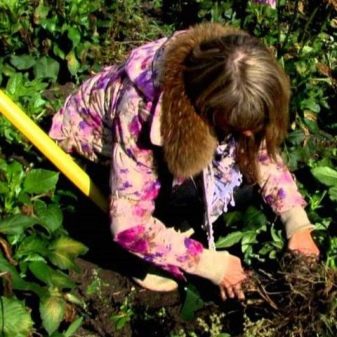
If it is sunny and dry outside, then the bulbs are left in the flower bed for several hours, after which the dried substrate is shaken off from them and examined for rot and damage. When putrefactive processes are detected, the affected tubers are thrown away, and the healthy ones are thoroughly washed in water, long roots are cut off from them and dried. Old tubers are also disposed of, as they may not bud and are poorly preserved. They are very easy to recognize by their darker coloration, large size and distinct tuberosity.
As a preventive measure the bulbs are recommended to be treated with any fungicidal preparation, for example, "Fitosporin". In its solution, the tubers are kept for an hour. If there is no way to get a ready-made fungicide, then you can use a weak solution of potassium permanganate, only the tubers can be kept in it for no more than 30 minutes. While the bulbs are soaked in the solution, it is necessary to prepare tags with the names of varieties, and if their names are unknown, briefly describe the color and size of the bushes.
The next step in preparing the bulbs for wintering is drying them. To do this, choose a dark, cool place and arrange the tubers with the stem down. This facilitates the outflow of the liquid accumulated in them and prevents root rot. To prevent rapid drying of tubers, it is not recommended to place them for drying in warm, dry rooms. The best option would be to lay out dahlias on a veranda, loggia or in a greenhouse.
After 3-5 days, the surface is completely dry and the bulbs are completely ready for winter storage.

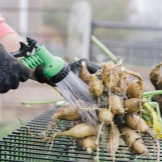
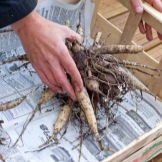

Storage conditions
In order for dahlias to be well preserved until spring and to sprout quickly, they need to create comfortable conditions. The optimum storage temperature for tubers is +5 degrees with an air humidity of 60-75%. At the same time, the room should be well ventilated, and dry sand, sawdust or wood should be used as a substrate. This will promote good air circulation around the tubers and prevent fungal infections. These conditions are easiest to create in cellars, outbuildings and garages.
So, in basements and cellars, it is generally always cool and humid, which will not allow the tubers to dry out or germinate ahead of time. Undergrounds are slightly less suitable for storage: the humidity in them is much lower than in the basement, and the air temperature is usually higher. In addition, air movement is limited there, and it often stagnates. In this regard, the underground is recommended ventilate more often, and turn on a fan once a week.
If dahlias are planned to be stored on a glazed loggia, then you need to choose the darkest place and place the box with bulbs there. When the outside temperatures drop, the container is covered with an old blanket, and during severe frosts, it is completely taken into the house. If there is no balcony, underground or basement, then dahlias can be placed in the refrigerator. The tubers are placed in a bag with sawdust and several holes are made in it.
Dahlias are stored on the bottom shelf or in the vegetable tray.



Once a month, an audit is required, and when the first signs of damage are found, the bulb is unconditionally destroyed, and neighboring specimens are treated with potassium permanganate. If the process of decay is just beginning, then the tuber can be completely saved. For this, the affected areas are cut off with a sharp disinfected knife, and the cut sites are treated with a fungicide. When storing in basements and underground, care must be taken to protect the tubers from pests.
To do this, you can use poisonous baits or an ultrasonic repeller. In addition, rodents do not tolerate the smell of peppermint essential oils, which is why a paper napkin dipped in them and placed in a glass jar will effectively scare off mice and rats.
The only drawback of this method is the need to replace the soaked wipes with new ones on a weekly basis.


The ways
You can store dahlia tubers in different ways, and in order to choose the most suitable one, you need to familiarize yourself with the pros and cons of each of them.
Sand box
Storing dahlias in sand boxes is the oldest and most proven method. Its main advantages are material availability and ease of use. The disadvantages include the risk of early germination of tubers and a high probability of rotting of the bulbs with an increase in the moisture content of the sand. Therefore, when using this method, it is necessary to ensure that the substrate is dry, since it is no longer possible to revive rotten bulbs.
The best option would be to use river sand. It does not absorb moisture and does not deplete flower tubers. For these purposes, take large wooden boxes or plastic buckets with a capacity of 20 liters, stack the tubers in rows and sprinkle them abundantly with sand. A canvas bag is put on top of the boxes, and they are removed to the cellar.

Sawdust
This method is considered one of the most effective and efficient. It is better to choose large sawdust, mixed with shavings... There is only one drawback of this method, and it is more likely associated with errors in its application than with the properties of the sawdust themselves. For example, many gardeners make the mistake of putting the bulbs in the sawdust in plastic bags. As a result, condensation forms inside the cellophane, sawdust gets wet, and the tubers rot.
As an exception, this method can be used when placing bags in the refrigerator with the condition of constant monitoring of the presence of condensation.
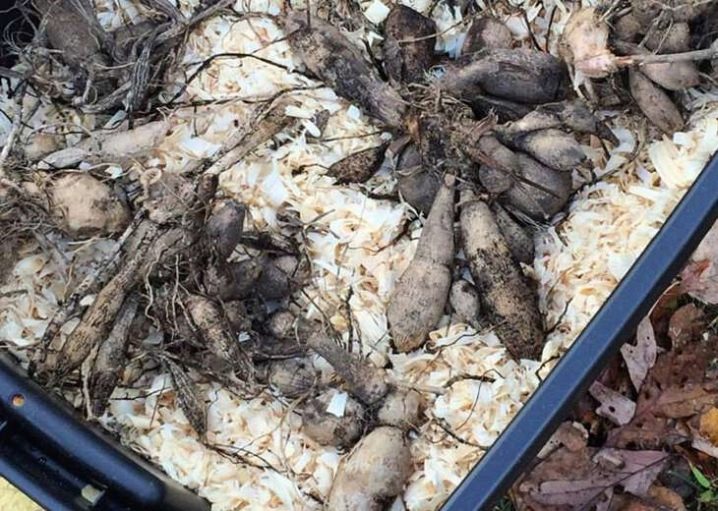
Vermiculite
The material is distinguished by its ability to retain moisture well and allows you not to worry about drying out the roots. However, this coin has another side: even with a slight increase in temperature, the tubers can prematurely sprout, which is extremely undesirable in winter.
That's why to prevent such situations, you should use not garden, but large-fraction vermiculite. To implement this method, a layer of vermiculite is placed on the bottom of the box, on which dahlia bulbs are placed. Thus, the entire container is filled, covered with cellophane on top and removed to a cool room.
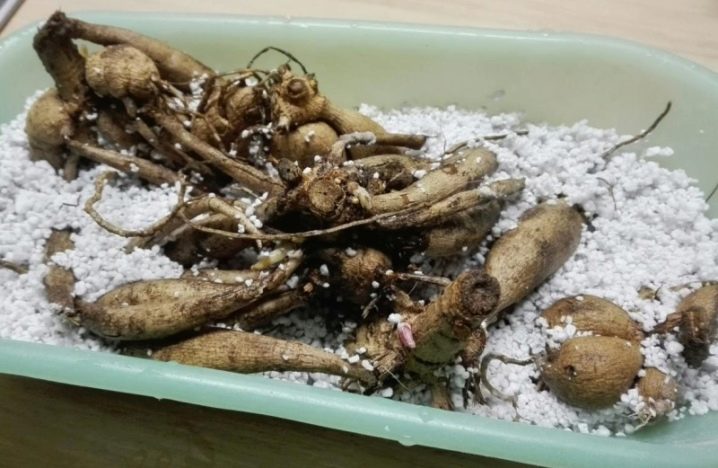
Paraffin
This method is the most effective, but it requires special painstaking and time-consuming. A dense layer of paraffin prevents moisture from evaporating and protects the tubers from drying out. Moreover, the high temperatures affecting the tubers during processing kill the pathogenic microflora, exclude the development of infectious and fungal diseases, and the frozen paraffin protects the roots from the harmful effects of external factors. However, this method can only be used for early varieties of dahlias. This is due to the fact that the buds awaken from paraffin much later, and suction roots are formed on the tubers.
In order to properly preserve the dahlia tubers in paraffin, you need to grind candles or lumpy paraffin, put it in a metal cup and warm it up in a water bath. After the thickness of the molten paraffin reaches 2 cm, tubers tied on a thread are dipped into it, after which they are taken out and the substance is waiting for hardening. If the tuber does not fit in the cup, then before immersion it is divided, the threads are tied, and each part is dipped in paraffin. The bulbs are then placed in a box, bucket, or cardboard box and stored in a cool place until spring.
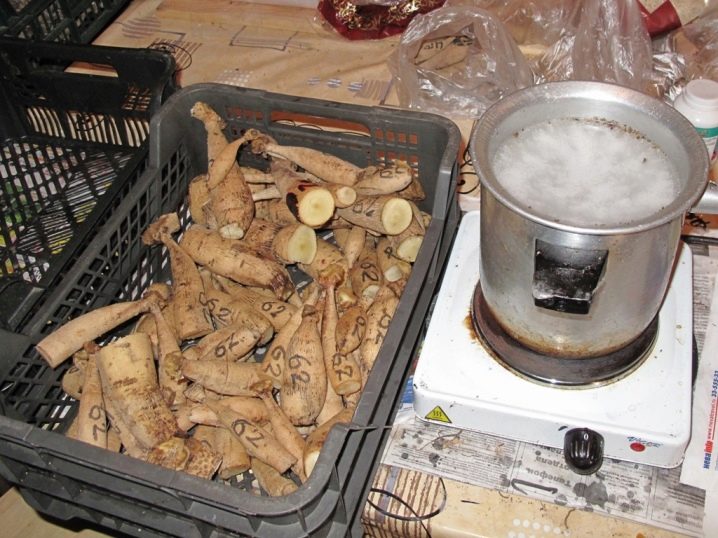
Peat
In order to preserve the dahlia bulbs in this way, tubers and peat are laid on the bottom of a wooden box in layers, and the container is removed in a dark and cool place. The bulbs are pretty well preserved, however, if the temperature regime is violated, premature germination is possible.
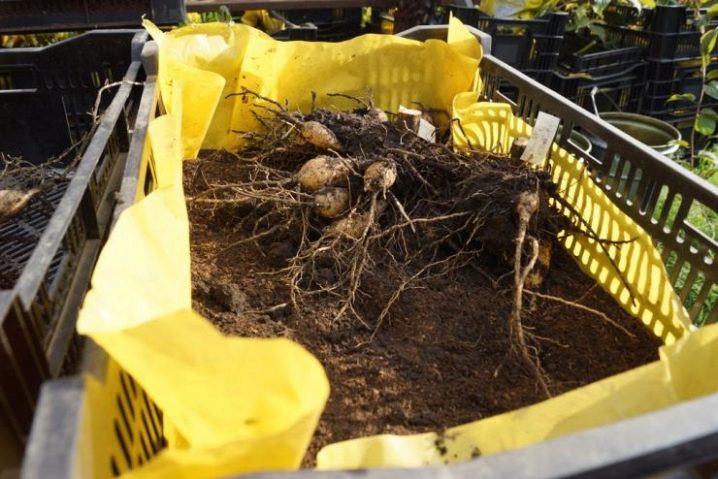
Clay
The clay shell perfectly protects the tubers from drying out and contributes to the good preservation of the roots. It is important to dry the dahlias well before using this method, otherwise they may rot.
First, a clay mash is made with a consistency reminiscent of thick sour cream, a small amount of fungicide is added and mixed well. Then each onion is dipped in a mash and dried for 3-4 days. Next, the tubers are stacked in rows in boxes and placed in a cool, dry room. In the spring, before planting on a flower bed, the clay crust is removed with light tapping.
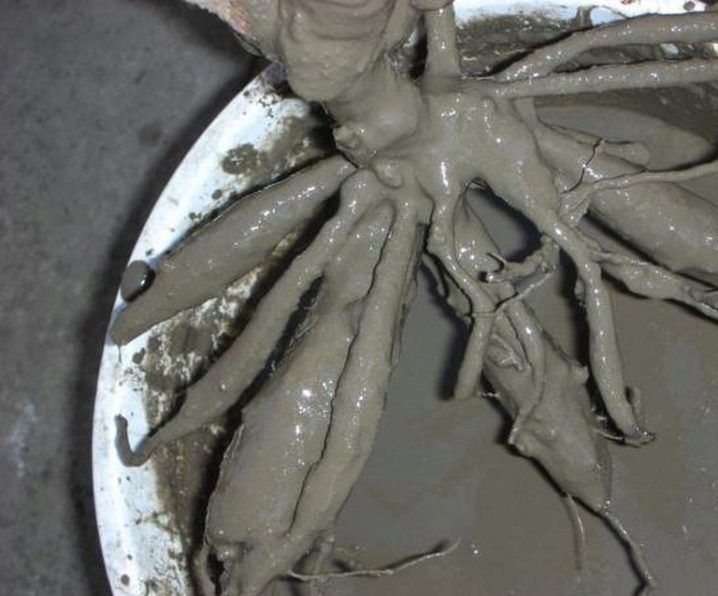
Cling film
This technique is quite new and has both supporters and opponents. Washed and dried tubers are wrapped in foil, folded into boxes and sent to storage. So that they do not sprout and mold, the mode in the room must be strictly observed: the recommended temperature is +3 degrees, humidity - 70%. If these conditions are not met, the tubers quickly rot and begin to rot.
Whichever of the considered methods is used, a prerequisite is the absence of potatoes and other root crops in the immediate vicinity.
This is due to the increased moisture that forms around vegetables and the risk of fungal diseases.
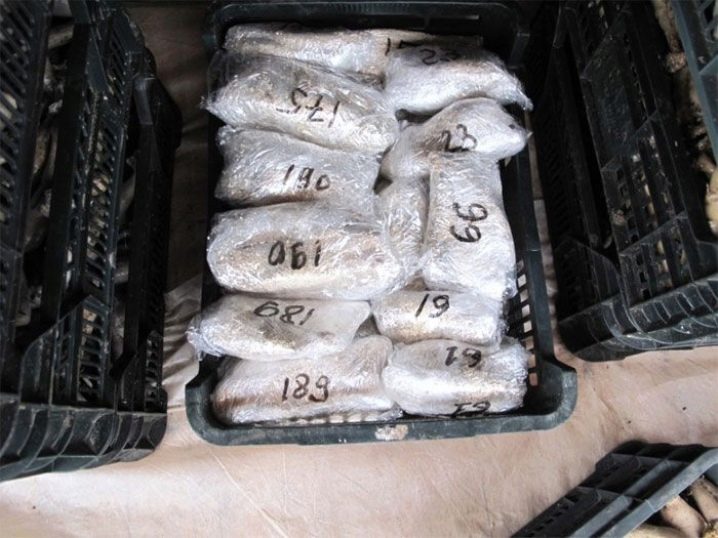
What happens if you don't dig up the tubers?
Novice gardeners often wonder whether it is necessary to dig up tubers for the winter, and whether this painstaking procedure can be avoided. Unfortunately, in most regions of our country, winters are very cold, and already in November there are severe frosts.
That's why, if dahlias are planned to be grown as a perennial plant, then the autumn digging of tubers is mandatory. If the flowers grow like annuals, then you can not bother and leave the tubers in the ground. This method of growing flowers can be used by people who do not have a basement, garage or other place where the desired temperature and humidity regime could be maintained during the winter.
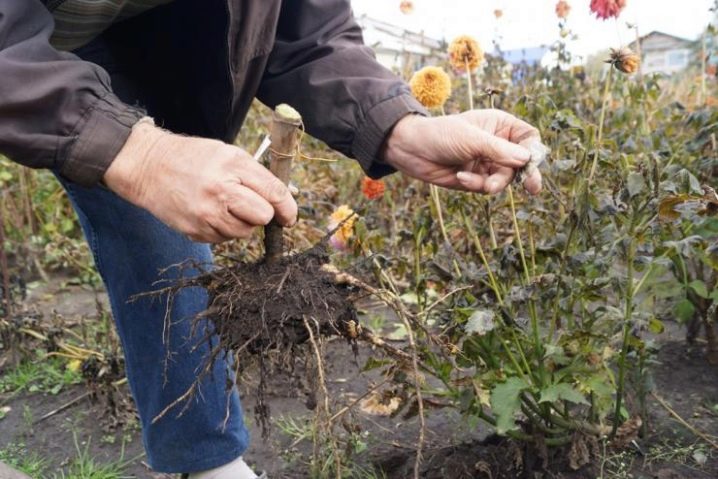
What happens after wintering?
As spring approaches, gardeners begin to think about what to do next with tubers, and how to "reanimate" them. If the bulbs have survived the winter well and are in perfect condition, then there are no problems: they are quite ready for awakening and planting, and will soon sprout quickly and give color. But more often it happens that it is not possible to preserve the tubers in their original form, and numerous drying of the roots is noted. In such cases, the bulbs are carefully examined, and if they have not completely dried out, but only wilted, then they begin urgent rehabilitation.
To do this, take a small container, fill it with a nutrient mixture, peat or large sawdust. Then the wilted tuber is placed in the filler in a horizontal position, trying not to deeply deepen.
It is necessary to ensure that so that the root collar is completely open. Further, according to the instructions, they are bred preparations "Epin-Extra" or "Zircon", and generously spray the planting. The container is installed on the windowsill and provides the plant with bright, but at the same time, diffused light. To do this, use a sheet of loose paper glued to the glass with scotch tape, as well as gauze or a tulle curtain.
This procedure is performed at the beginning of March, so that the plant has time to recover from wilting and wake up.

If damage to the bulbs was noticed on time, and measures to save them were taken correctly and quickly, then after 3-4 weeks you can wait for the first shoots to appear. During this time, it is necessary to monitor the condition of the filler, to prevent it from drying out or excessive moisture. The latter will quickly lead the weakened tuber to rotting, and then it will definitely not be possible to save it. After the plant has come to life, it is provided with good lighting and moderate watering. Top dressing at this stage is prohibited.
If the tubers have survived the winter well, then another method can be used to awaken them.It is well suited in cases where there is no way to get the filler, but it is already necessary to awaken the plants from hibernation. To do this, take an ordinary transparent plastic bag, and place the tuber in it. Then a solution of any growth stimulant is prepared, and the dahlia is sprayed. Next, the bag is slightly tied and a small hole is left for air circulation, after which it is placed in a warm and well-lit place. In this case, the light can no longer be scattered, since the polyethylene will do it on its own.
As the moisture evaporates from the bag, the onion is sprayed and awaited for its awakening.
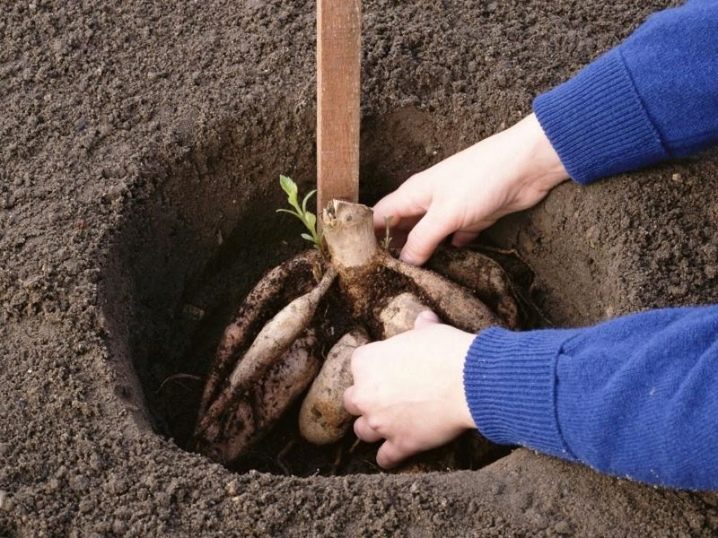
The dahlia wakes up pretty quickly, and after a month the first strong shoots appear. After they reach a length of 5 cm, the bulbs are planted in a flower bed, and if it is still quite cold outside and the earth has not warmed up above +10 degrees, then they are planted in pots and kept in the apartment for some time.
When dahlias are planted in open ground, they must be spilled, and in the event of a threat of recurrent frosts, they are covered from above with any non-woven material, for example, agrospan or lutrasil. After the threat of nighttime temperature drops has passed, the plants cease to cover and are transferred to the usual summer mode of care.
For information on when to dig dahlias in the fall and how to store them in the winter, see the next video.

































































































The comment was sent successfully.